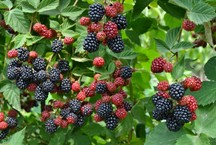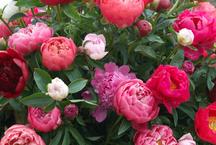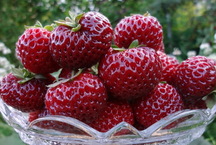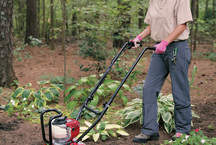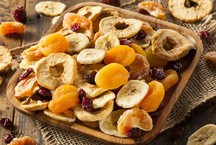Top 10 varieties of honeysuckle
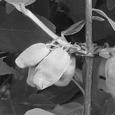
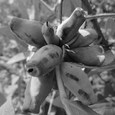



Honeysuckle - srednerosly shrub from Siberia. High frost resistance in her genes. Honeysuckle is adapted to grow in a short summer: the vegetation begins early, the flowers can withstand temperatures as low as minus 7-10 degrees, and the berries ripen in the earliest periods. We present you the description and photos of the best varieties of honeysuckle - according to experienced gardeners.
In the selection of varieties for the orchard 2 types of honeysuckle are used: edible and blue. The first species is a low-growing shrub up to 1 m high, and the second is a standard plant 2-2.5 m high.
In the middle zone of the shrub blooms with the first spring warming, often when there is still snow. The period of active growth of shoots is short: in August, the shrub enters a stage of rest. This physiological peculiarity in the conditions of warm autumn and mild winter with rains can lead to repeated autumn flowering or to awakening in the middle of winter. Plants that began to grow during a long thaw are significantly damaged by severe frosts. But, according to the experience of summer residents, the honeysuckle is quickly restored, and old bushes bear fruit even after severe winters.
Honeysuckle berries characteristic astringency or bitterness, but breeders managed to reduce this feature to a slightly perceptible taste. There are varieties with a simple sweet taste. Experienced gardeners, when selecting the best varieties of honeysuckle, put the main criterion not in taste, but in yield, ripening amity, bush habit and size of berries. If you plan to freeze and process, then choose technical varieties of honeysuckle with good yields, and sour taste can be easily eliminated by adding sugar.
Rating of the best varieties of honeysuckle
| Category | A place | Name | Rating | Price |
|---|---|---|---|---|
| The best early varieties of honeysuckle | 1 | Blue Cliff | 9.9 / 10 | 400 |
| 2 | Ussulga | 9.9 / 10 | 270 | |
| 3 | Long-fruited | 9.8 / 10 | 250 | |
| 4 | Tomichka | 9.8 / 10 | 250 | |
| 5 | Moscow 23 | 9.7 / 10 | 250 | |
| 6 | Blue bird | 9.7 / 10 | 230 | |
| Top Middle and Late Honeysuckle Varieties | 1 | Yugana | 9.9 / 10 | 300 |
| 2 | Bakchar giant | 9.9 / 10 | 270 | |
| 3 | Indigo Gem | 9.8 / 10 | 350 | |
| 4 | Commonwealth | 9.7 / 10 | 250 |
The best early varieties of honeysuckle
|
Blue Cliff
400 (one-year-old in a container)
New Bakcharsky honeysuckle variety. Low-growing bush, height 1.2 - 1.5 m, semi-sprawling, shtambovy. The berry is dark blue, with a dense wax coating, elongated, hilly, weighing 1.6 - 2.6 g, lined, with dense flesh, dessert sweet-sour taste. The berries are not showered, but the collection is allowed by shaking off, they come off without a “tail”, they retain their shape. The average productivity of an adult bush is 3.5 kg. This variety of honeysuckle is grown in the northern regions and Siberia, promising for the Central zone. It is pollinated by other early flowering varieties. Main advantages:
Minuses:
|
 9.9 / 10
Rating
Reviews
Worthy variety, one of the most delicious in my collection. Young bush is small and convenient to collect. |
|
Ussulga
270 (1-year-old sapling in a package with peat)
A good new variety of honeysuckle Bakchar selection. The bush is powerful, standard, with an oval crown, it grows rapidly, with a height of 1.9 - 2.1 m. The berry is oblong, oval, barrel-shaped, smooth with a slight tuberosity, weighing 1.7 - 2.2 g, with a dense waxy coating. The flesh is juicy, fleshy, without voids. The taste is sweet and sour, soft, no bitterness. The productivity of an adult plant is 2.5-4 kg. Gardeners only monitor the adaptability of the variety, which can be judged after 5 - 7 years. Celebrate excellent taste and attractiveness of the berries. Main advantages:
Minuses:
|
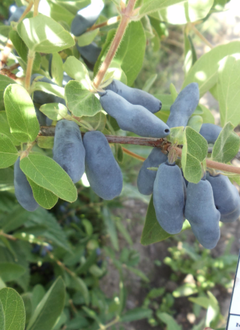 9.9 / 10
Rating
Reviews
The berries have a magic taste: with mild sourness, not unleavened! It is pleasant to collect them: beautiful leveled berries on the branches protruding upwards. |
|
Long-fruited
250 (a sapling 25 cm high in the container on 2 l)
A good large-fruited honeysuckle variety of South Ural breeding continues our rating. Sprawling bush, 1.3 m high, with curved shoots. Blue berry with a purple hue, oblong, 2.5 - 3 cm long, compressed laterally, with a dull apex, slightly hilly, weighing 1 - 2 g. Pulp with voids, sweet and sour, without bitterness, juicy, with a fresh aroma. Productivity from 1,5 to 3 kg. This variety of honeysuckle bred for the Ural climate, has proven itself in the Leningrad region, the Moscow region and the middle belt. Adapted to mild winters and returnable frosts. In dry conditions without proper watering, the berries acquire a pleasant bitterness. Main advantages:
Minuses:
|
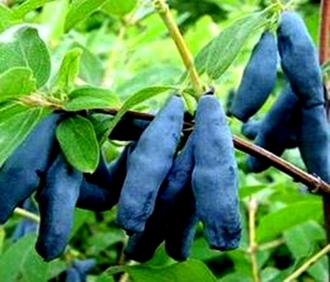 9.8 / 10
Rating
Reviews
If the berry is overexposed for several days, it does not pour out, but it is gaining more sugars. In cool rainy years, the berries are sour. |
|
Tomichka
250 (one-year sapling with ZKS)
Known Bakchar varieties of honeysuckle. Bush 1.5 - 1.7 m tall, compact, semi-sprawling, with curved tops of shoots. The berry is dark purple, with a smoky bloom, cylindrical, pitcher-shaped, slightly bumpy, with a depressed apex, 2.5 cm long, weighing 1.2-1.5 g. The flesh is juicy, sour-sweet, without bitterness. Ripe berries quickly showered, so the collection is carried out in several stages. Delicate and thin skin does not allow to transport the berry. The yield from an adult bush 2.5 - 3.5 kg. The collection is carried out by shaking off. High frost resistance allows growing a variety in Siberia. This variety of honeysuckle is well adapted in the Moscow region and recommended for Central Russia. Bluebird, Blue Spindle, Bakchar and Cinderella are planted as pollinators. Main advantages:
Minuses:
|
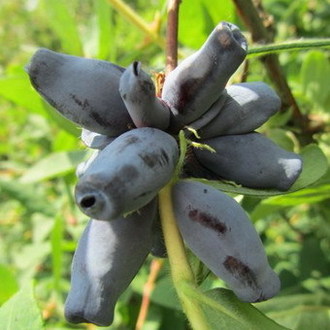 9.8 / 10
Rating
Reviews
Decorative bush with a good habit. Berries grow in clusters, it is easy to pick them, just fall into the palm. Productivity is not the highest, but stable, even in an unfavorable location of the site. |
|
Moscow 23
250 (35 cm tall sapling in 2 l container)
Proven Moscow honeysuckle variety. Bush 1.8 - 2.5 m tall, strongly sprawling, powerful, with straight shoots. The berry is blue, spindle-shaped, wide, narrowed to the top, with a dense wax coating, weighing up to 1 g, 1.5 - 2 cm long, hilly, with a dense skin. The pulp is fibrous, sweet-sour, with a strong aroma. It has a technical purpose. Productivity 2 - 4 kg. This variety of honeysuckle is zoned in the Moscow region and the Central region. Often used as an unpretentious hedge. As pollinators fit Titmouse and Fortune. Main advantages:
Minuses:
|
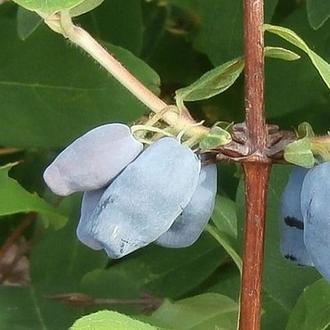 9.7 / 10
Rating
Reviews
Always with the harvest, but the berries with astringency - good for processing. |
|
Blue bird
230 (one-year sapling)
Old variety of honeysuckle Siberian selection. Sprawling bush, with an oval dense crown, 1.5 - 1.8 m high. Berry is dark blue, with a dense waxy coating, oval or barrel-shaped, with a "roller" at the top, 2 cm long, weighing 1 - 1.2 g , tender, sweet-sour with astringency and blueberry flavor. Adult shrub annually gives 1.5 - 2 kg of berries. Zoned for the North-West region. Good for growing in the middle zone and the Volga region.It is not exacting to soils and leaving. In the Moscow region and Michurinsk, there is a frequent autumn bloom. The best pollinators: Blue spindle, Kamchadalka, Cinderella. Main advantages:
Minuses:
|
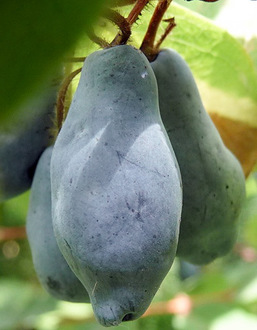 9.7 / 10
Rating
Reviews
Viable and reliable grade. The taste of berries depends on the care and weather conditions, but always pleasant for fresh use. Top Middle and Late Honeysuckle Varieties |
Top Middle and Late Honeysuckle Varieties
|
Yugana
300 (1-year-old peat seedling)
A new variety of honeysuckle Bakchar selection. The bush gives good annual growths, grows to a height of 1.5 m. The crown is compact, medium thick. Berry with a violet tinge and dense bluish wax bloom, pitcher-shaped, with a characteristic "roller" at the top, weighing 1.4 - 1.8 g, dense, sweet and sour taste without bitterness. In different climatic conditions, the shape of the berries varies. After ripening, the berries do not crumble, while at the same time collecting the whole harvest, some berries come off with a “tail”. Potential average productivity: 4 - 6 kg. This variety of honeysuckle is recommended in Siberia and in the northern regions, it is grown by gardeners of the Moscow and Ryazan regions. Ripens in average terms, in cool and rainy summer ripening of berries extended. Bakcharsky giant, Delight, the daughter of a giant, Strezhevchanka are suitable as pollinators. Main advantages:
Minuses:
|
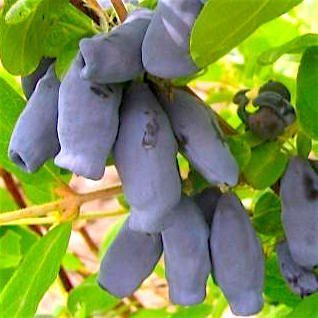 9.9 / 10
Rating
Reviews
The advantages of the variety, except for tasty and large berries, include a good growth force and vertical habit: the bush does not fall apart and does not spread along the ground. |
|
Bakchar giant
270 (sapling with ZKS)
Bakcharsky large-fruited honeysuckle variety for Siberia and Central Russia. The bush is powerful, up to 1.8 - 2 m high, with an oval crown. Sprawling branches. Sparse crown facilitates harvesting and improves illumination. The berry is rich blue, elongated-cylindrical, slightly hilly, 3–4 cm long, weighing 1.5–2 g, sweet and sour with a slight bitterness, with dense and tender flesh, rarely with voids. Designed for fresh use. Productivity is 1,5 - 2 kg. When ripe, do not postpone the collection, as the berries quickly fall off. Although this disadvantage accelerates the collection, if you lay a film or light fabric under the bush and shake it off. This variety of honeysuckle is highly frost resistant, but is not suitable for growing in the southern regions with frequent thaws in the winter. Good winter hardiness has shown in Moscow, Tver, Novosibirsk, Samara regions. In years with a warm protracted autumn, a single re-flowering is observed, which does not affect future fruiting. As pollinators recommend Nymph, Silginka, Bakchar Pride, Azure. Main advantages:
Minuses:
|
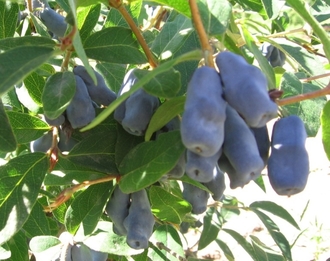 9.9 / 10
Rating
Reviews
The berry is large, beautiful and very tasty. The bush is rare: it is convenient to harvest the crop and it is not necessary to suffer with pruning. |
|
Indigo Gem
350 (one-year-old sapling in a 0.5 l container)
Canadian high-yielding variety of honeysuckle. Shrub neat, spreading to the top, 1.5 - 1.7 m high. High growth power, powerful annual growth. Berry black-purple, oval, smooth, weighing 1.0 - 1.3 g, Pulp is dense, gel-like consistency, without voids, sweet and sour, with tartness. Originator claims yield up to 4 - 5 kg per bush. This variety of honeysuckle well manifested itself in the Moscow region, Ryazan region. Differs in high winter hardiness. The first harvests form 2 - 3 years after planting. Pollinators: Aurora, Honeyibi. Main advantages:
Minuses:
|
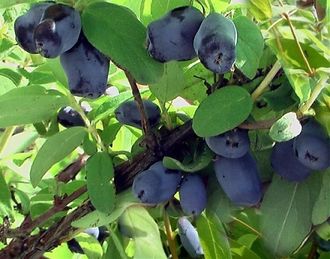 9.8 / 10
Rating
Reviews
It attracts with interesting harmonious taste and yield, but in Russian conditions adaptation is required. |
|
Commonwealth
250 (seedling in a package with peat)
Old St. Petersburg variety of honeysuckle, included in the State Register. Bush height up to 1.8 - 2 m, spreading. The shoots are curved, powerful. The berry is bluish, oval, strongly lumpy, with a sharp top, up to 3 cm long, weighing 1.3 - 1.5 g, with a thin and delicate skin, strong acidity in taste, and weak bitterness. Frost resistance is average, but sufficient for the Middle band. Winter hardiness is high, adapted for a mild winter. A good grade of honeysuckle for the Moscow and Leningrad regions. Main advantages:
Minuses:
|
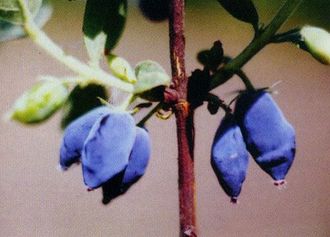 9.7 / 10
Rating
Reviews
Reliable large-fruited variety with a stable yield. Good for both fresh use and for freezing. |
The main method of breeding varietal honeysuckle bush -grafting. It is used by private fruit growers. In large nurseries, you can purchase a microclonal propagation seedling (in vitro). Varietal honeysuckle is self-infertile, thereforeimmediately acquire 3 seedlings of different varieties, but one flowering period. If you want to extend the use of healing berries and plant a late variety, then he also needs to pick up a pollinator.
Relying on the experience of amateur gardeners, you can pick up a decent collection of reliable varieties. But taking into account the re-grades and the variability of natural and climatic conditions even within the same region, it will take more than one year to fill the berry. It is better to start with local varieties of honeysuckle, purchased from private traders directly from the site. Get valuable varieties and novelties in large nurseries with a good reputation. Have a good harvest!

